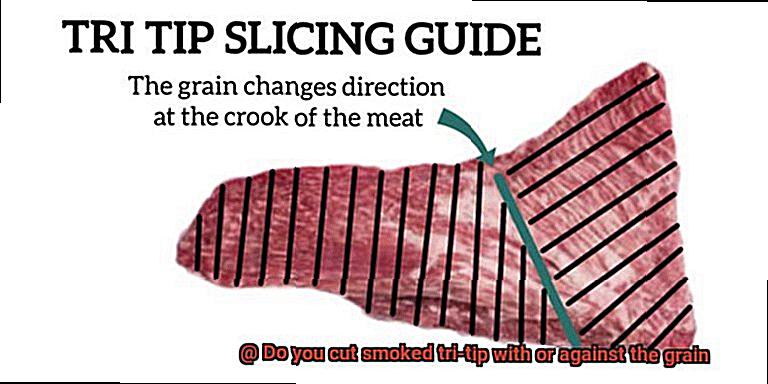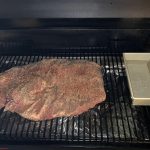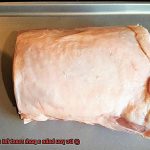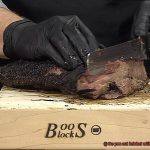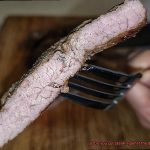Are you a meat enthusiast? If so, then you must be familiar with tri-tip – that delightful and succulent cut from the bottom sirloin that’s perfect for grilling, smoking, and roasting. However, when it comes to slicing it up, do you know which direction to cut? With or against the grain?
It’s a culinary puzzle that has left many cooks scratching their heads. But don’t worry; in this post, we’ll explore everything you need to know about slicing smoked tri-tip with or against the grain. We’ll cover what the grain is (hint: it’s not the wood that your smoker uses.), why it matters for your tri-tip, and how to determine which way to slice.
But before we dive into the specifics, let’s start with some context. Tri-tip is an adored cut of beef in many regions of the US, especially in California where it originated. It’s a versatile cut that cooks quickly and doesn’t require any complicated techniques or fuss. Additionally, its natural marbling and tenderness make it an excellent choice for smoking. And when done correctly, it’s a melt-in-your-mouth delicacy.
So, if you’re eager to learn how to slice this luscious beef cut like a pro, keep reading to discover whether you should cut smoked tri-tip with or against the grain.
Contents
What Does It Mean to Cut With or Against the Grain?
Or maybe you’re a home cook eager to impress your dinner guests with perfectly cooked beef. Either way, understanding how to cut with or against the grain is an essential skill for achieving optimal tenderness and flavor in your meat.
In simple terms, the grain of meat refers to the direction of the muscle fibers. When you cut with the grain, you’re slicing parallel to these fibers, leaving long strands intact. This can result in tougher, chewier meat. Conversely, cutting against the grain involves slicing perpendicular to the muscle fibers, breaking them up and resulting in a more tender and easier-to-chew piece of meat.
Now, let’s talk about smoked tri-tip. This lean cut of beef is a popular choice for grilling and smoking, but it requires careful attention to cutting technique to avoid toughness. To identify the direction of the grain, look for lines running through the meat that indicate the direction of the muscle fibers. Once you know which way they’re running, use a sharp knife to slice against the grain for optimal tenderness and flavor.
But cutting against the grain isn’t the only trick to perfecting your smoked tri-tip. Using a sharp knife is crucial – a dull blade can tear the meat and make it more difficult to cut cleanly against the grain. Additionally, letting your meat rest for a few minutes after cooking allows juices to redistribute throughout the meat, making it more tender and flavorful.
So, why does all this matter? Well, cutting with or against the grain can make all the difference in achieving that melt-in-your-mouth texture that makes for a truly satisfying meal. Whether you prefer a chewier texture or want an easy-to-chew bite, understanding how to cut with or against the grain is key.
Why Does Cutting with or Against the Grain Matter for Smoked Tri-Tip?
This seemingly small detail can make a world of difference in the tenderness, texture, flavor, and appearance of your meat.
Let’s dive deeper into why cutting against the grain matters. The grain refers to the lines of muscle fibers in the meat, and cutting against it means slicing perpendicular to those lines. This technique breaks up the muscle fibers, resulting in a more tender and easier-to-chew bite. On the other hand, cutting with the grain can leave those muscle fibers intact, leading to tougher and chewier meat.
This concept is especially crucial for smoked tri-tip, which is a lean cut of beef that can easily become tough if not sliced properly. By cutting against the grain, you can maximize the tenderness of the meat and enhance its natural flavor profile. Trust us when we say that this attention to detail will take your smoked tri-tip to a whole new level of deliciousness.
But there’s more to consider than just tenderness and flavor. Cutting with or against the grain also impacts the appearance of your meat. Slicing against the grain creates shorter, more even slices that showcase the beautiful marbling and color of the meat. These shorter slices also help distribute those juicy flavors throughout every bite. In contrast, cutting with the grain can result in longer, stringy slices that are less visually appealing and less enjoyable to eat.
What Are the Benefits of Cutting with the Grain?
In our previous section, we explored the benefits of cutting against the grain, but now it’s time to discover what cutting with the grain can do for your smoked tri-tip.
Cutting with the grain is like a secret weapon that can elevate your smoked tri-tip to new heights. One of the biggest advantages is that it helps ensure your meat stays tender and juicy. When you cut against the grain, you slice through muscle fibers, causing them to shrink and become tougher. However, when you cut with the grain, you keep those muscle fibers intact and preserve their natural juices and flavors. This means every bite is bursting with succulent flavor.
Another benefit of cutting with the grain is that it helps prevent the meat from falling apart or becoming stringy. This is especially important when dealing with larger cuts of meat. Slicing against the grain risks separating muscle fibers and creating a less cohesive piece of meat. But when you slice with the grain, you keep those fibers together and create a more uniform texture, resulting in a satisfyingly chewy bite.
Lastly, cutting with the grain can help create a beautiful presentation for your smoked tri-tip. When sliced against the grain, it can appear frayed or shredded, which detracts from the overall appearance of your dish. But when you cut with the grain, you create clean, uniform slices that are visually appealing and give off an air of professionalism.
What Are the Benefits of Cutting Against the Grain?
As an expert in the craft of meat preparation, I can assure you that this is a game-changer when it comes to creating a succulent, flavorful meal.
Cutting against the grain involves slicing through the muscle fibers of the meat, which shortens them and makes them more tender. This results in a mouth-watering piece of meat that practically melts in your mouth. It’s also easier to chew, which means you can savor every bite without feeling like you’re working for it.
But the benefits don’t stop there. Cutting against the grain also allows for better flavor absorption. The natural juices and flavors of the meat are concentrated within the muscle fibers, so exposing them through cutting allows for better distribution throughout the meat. This means that every inch of your cut will be bursting with flavor.
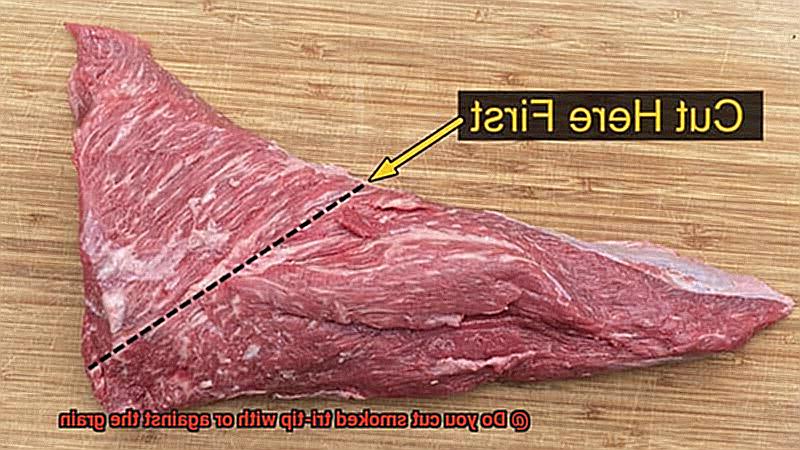
And let’s not forget about presentation. Slicing against the grain creates shorter, more uniform slices which can make for a more aesthetically pleasing dish. Plus, it’s a great way to impress your guests with your culinary skills.
Tips for Cutting Smoked Tri-Tip
If you’re a fan of smoked tri-tip, then you know that it’s all about achieving the perfect flavor and tenderness. But did you know that the way you cut your tri-tip can make or break the final product? That’s why understanding the direction of the grain is crucial.
The grain refers to the lines of muscle fibers that run through the meat. Cutting with or against these fibers can have a significant impact on the texture and tenderness of your tri-tip. But if you want your smoked tri-tip to be as tender and flavorful as possible, then it’s essential to cut against the grain.
When you slice against the grain, you’re essentially breaking up those long strands of muscle and making them shorter and easier to chew. This results in a more tender texture and more flavorful bites. On the other hand, cutting with the grain can lead to tougher and chewier meat, with less flavor.
To cut against the grain, start by identifying which direction the grain runs in your tri-tip. You should be able to see lines or striations running across the surface of the meat. Use a sharp knife to cut perpendicular to these lines, slicing across the grain rather than with it.
But before you start cutting, be sure to let your tri-tip rest for at least 10-15 minutes after smoking. This allows the juices to redistribute throughout the meat, resulting in a more flavorful and tender final product.
When it comes time to cut, use a sharp, serrated knife. A dull knife will tear and shred the meat, resulting in uneven slices and an unappealing presentation. Take your time and use a gentle sawing motion to ensure clean, even cuts.
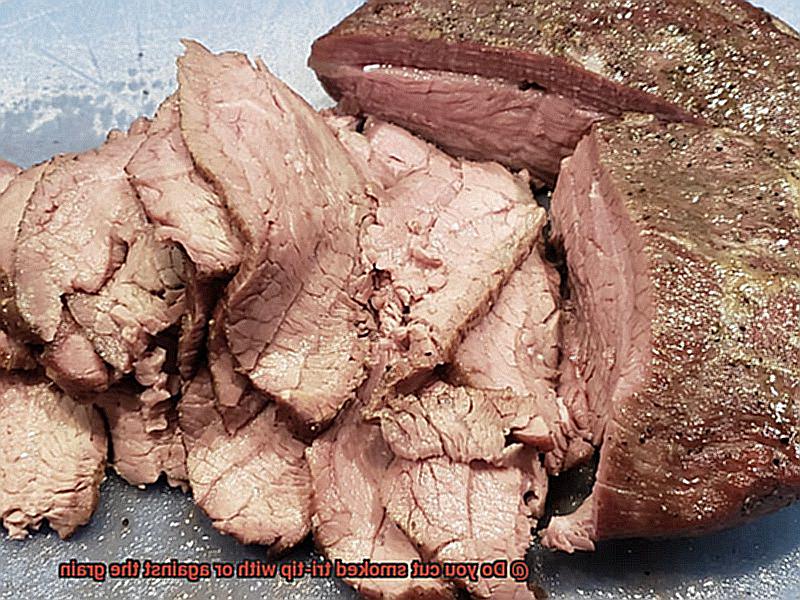
Some people prefer thin slices for sandwiches or tacos, while others opt for thicker cuts for a more substantial main dish.
Different Ways to Cook Smoked Tri-Tip
Smoked tri-tip is a delicious and popular cut of meat that can be cooked in several different ways to produce varying flavors and textures. Let’s explore the different methods of cooking smoked tri-tip and how to properly slice it for optimal tenderness and juiciness.
Smoking is a slow-cooking method that infuses the tri-tip with flavor and creates a tender texture. To smoke tri-tip, you’ll need to set your smoker to a temperature of around 225-250 degrees Fahrenheit and let the meat smoke for two to three hours. This method results in a moist and flavorful cut of meat that pairs well with a variety of sides.
Grilling is a faster cooking method that produces a delicious charred flavor. To grill smoked tri-tip, preheat your grill to high heat and cook the tri-tip for six to eight minutes on each side. This method is perfect when you’re short on time but still want a flavorful meal.
Searing involves cooking the tri-tip on high heat for a short period of time to create a crispy outer layer while retaining the juicy interior. To sear smoked tri-tip, heat up a cast-iron skillet or grill pan over high heat, place the tri-tip in the pan, and cook for two to three minutes on each side. This method creates a delicious crust on the outside while keeping the meat tender and juicy on the inside.
No matter which cooking method you choose, it’s important to let the smoked tri-tip rest for at least 10 minutes before slicing into it. This allows the juices to redistribute throughout the meat and ensures that it stays moist and flavorful.
When it comes to slicing smoked tri-tip, cutting against the grain is key to maximizing tenderness and juiciness. Slicing against the grain means cutting perpendicular to the lines or fibers running through the meat, which cuts through muscle fibers instead of with them. This results in tender, juicy slices of meat that are easy to chew and enjoy.
How to Tell When Your Smoked Tri-Tip Is Done
Smoked tri-tip is a mouth-watering cut of meat, but determining when it’s done can be a challenge. Luckily, there are some ways to tell if your smoked tri-tip is ready to be served.
Check the Internal Temperature
Using a meat thermometer is one of the most reliable methods for determining the doneness of smoked tri-tip. The ideal temperature for medium-rare is between 130-135°F, while medium should be cooked to between 140-145°F. Insert the thermometer into the thickest part of the meat and wait for the reading.
Observe the Color of the Meat
Another way to tell if your smoked tri-tip is done is by observing its color. As it cooks, the exterior forms a crust while the interior remains juicy and flavorful. When the meat has reached a brownish-red color on the outside, it’s a good indication that it’s done.
Perform a Touch Test
You can also use your fingers to determine the doneness of your smoked tri-tip. When rare, it feels soft and squishy. As it cooks, it becomes firmer and springier. When done, it should feel firm but still have a little bit of give.
Look for Bubbling Juices
As your smoked tri-tip cooks, you’ll notice juices start to come out of the meat and form small bubbles on top. This means that the moisture inside the meat has been released and cooked off, indicating that it has been cooked properly.
Slice Against or With the Grain
Slicing against the grain means cutting perpendicular to the muscle fibers, creating shorter muscle fibers resulting in more tender meat. Cutting with the grain creates longer muscle fibers that can be tougher and harder to chew.
It’s important to let your smoked tri-tip rest for at least 10 minutes before carving it; this allows the juices to redistribute throughout the meat, resulting in a more tender and flavorful end product. When carving, always slice against the grain for optimal tenderness.
Best Practices for Serving and Storing Smoked Tri-Tip
We’ve got you covered with the best practices for serving and storing smoked tri-tip.
First of all, don’t rush into slicing the meat right after it comes off the smoker. Give it a chance to rest for 10-15 minutes. This crucial step allows the juices to redistribute throughout the meat and create a more tender and flavorful final product.
Once your tri-tip has rested, it’s time to slice it up. Always slice against the grain, which means cutting perpendicular to the lines that run through the meat. By doing so, you break up the muscle fibers and achieve a more succulent bite. To determine which direction the grain runs, look for visible lines or fibers in the meat. Keep in mind that the direction of the grain may change throughout the cut, so adjust your slicing direction accordingly.
Your perfectly sliced smoked tri-tip is now ready to be stored properly. Wrap it tightly in foil or plastic wrap and keep it in the refrigerator. If you’re not planning on consuming it within a few days, you can also freeze it for later use. To thaw frozen smoked tri-tip, transfer it to the refrigerator and let it thaw overnight.
In summary, here are some essential tips for serving and storing smoked tri-tip:
- Let your meat rest for 10-15 minutes before slicing.
- Slice against the grain to achieve maximum tenderness.
- Wrap leftovers tightly in foil or plastic wrap and store in the refrigerator.
- Freeze any extra portions if not consuming within a few days.
- Thaw frozen smoked tri-tip by transferring it to the refrigerator overnight.
kcuIjkohu3c” >
Conclusion
In summary, smoked tri-tip is a versatile and succulent cut of beef that can be prepared in various ways to achieve distinct flavors and textures. However, when it comes to carving your meat, the direction in which you slice can make all the difference in achieving optimal tenderness and flavor. Slicing against the grain involves cutting perpendicular to the muscle fibers, which breaks them up and leads to a more tender piece of meat. Conversely, slicing with the grain preserves natural juices and flavors while keeping muscle fibers intact.
To ensure maximum tenderness when smoking tri-tip, it’s crucial to allow it to rest before carving and use a sharp knife to slice against the grain. Additionally, knowing how to determine when your smoked tri-tip is cooked to perfection will help you create mouth-watering dishes every time. Once sliced, leftovers should be stored correctly by wrapping tightly in foil or plastic wrap and storing in either the refrigerator or freezer.
Whether you’re an experienced carnivore or a home cook eager to impress your guests at dinner parties, mastering the art of slicing smoked tri-tip with or against the grain is an essential skill for achieving optimal tenderness and flavor.

